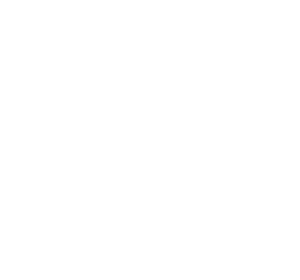WHAT IS BAG-ON-VALVE AEROSOL FILLING?
Bag-on-valve aerosol filling is the process of filling a flexible bag with a liquid or semi-liquid product and then sealing it inside a metal aerosol can along with a propellant. The bag is separated from the propellant by a valve, which controls the dispensing of the product.
The process typically involves several steps:
- The flexible bag is placed inside the metal can and the valve is attached to the top of the can.
- The product is then filled into the bag through a filling nozzle.
- The bag is then sealed and the can is filled with the propellant.
- The valve is then crimped onto the can to create an airtight seal.
The filling process is typically done using specialized equipment and automation to ensure accurate filling and consistent quality.
Once the can is filled, it is ready for dispensing. When the valve is actuated, the propellant pushes the product out of the bag and through the valve, dispensing it into the air as a fine mist or spray.
BOV aerosol filling technology is a versatile solution that can be used in a wide range of industries, including personal care, food and pharmaceuticals. Due to its consistent and controlled dispensing, it is ideal for products that require precise application, such as hair sprays, insect repellents and cooking oils.
What is bag on valve?
Bag-on-valve (BOV) is a packaging technology that allows for the dispensing of liquid and semi-liquid products in an aerosol can. The main component of a BOV system is a flexible bag made of plastic, which is placed inside a metal can. The bag is separated from the propellant by a valve.
When the valve is actuated, the propellant, which is typically a compressed gas such as air or nitrogen, pushes the product out of the bag and through the valve. The product is then dispensed into the air as a fine mist or spray. Because the product is contained in a separate bag, it is not in direct contact with the propellant, which reduces the risk of contamination and allows for a longer shelf life.
BOV technology is commonly used for dispensing personal care products such as hair spray, sunscreen, and insect repellent. It is also used for food products like whipped cream, cooking sprays, and salad dressings.
One of the main advantages of BOV technology is that it allows for more consistent and controlled dispensing of the product compared to traditional aerosol cans. Because the product is not in direct contact with the propellant, the amount of product dispensed is not affected by changes in temperature or pressure. This means that the product is dispensed at a consistent rate, which is especially important for products that are used in precise applications like hair styling or cooking.
Another advantage of BOV is that it is more environmentally friendly than traditional aerosol cans. The metal cans used in BOV systems are recyclable and the flexible bags are made of plastic which can be also recycled.
In summary, BOV is a packaging technology that allows for the dispensing of liquid and semi-liquid products in an aerosol can, with a flexible bag inside the can to separate the product from the propellant. This allows for consistent and controlled dispensing of the product and also it’s an environmentally friendly solution.
Bag On Valve Technology Shows Outstanding Advantages
The market has witnessed a rapid growth of Bag on Valve (BOV) technology these years, especially in the field of pharmaceutics, personal care, and household care.
Bag on valve technology shows its outstanding advantages in many aspects. It can isolate the product from the propellant gas, thus prolonging the shelf life dramatically. It uses non-flammable gas(Nitrogen or compressed air) as the propellant gas, which is much safer than the traditional aerosol technology. It is also able to eliminate the deterioration of product quality caused by the loss of solvent and decomposition of propellant.
It has been widely used in personal care, household care, food and beverage, pharmaceutics, etc.
The first Bag on valve technology was developed in Japan in the 1990s, and then it got very popular in Asia. It is still expanding rapidly in the European market. As a leader in this field, Nidec-Mitsui developed BOV technology for various industries (pharmaceuticals, cosmetics, etc.) over 10 years. The company based on its own rich experience and latest technologies proposed a wide range of BOV products to satisfy various needs of customers. Nidec-Mitsui’s BOV products are now exported to more than 50 countries/regions around the world with a high reputation among customers for their excellent quality and competitive price.
Pressure-free spray container (PFS) is a new type of spray container which has two parts: the bottle and the cap. The bottle is made of high-quality transparent material, such as polypropylene(PP), polyethylene(PE), polystyrene(PS), or polycarbonate (PC). The cap has a valve for controlling the spray direction. It is pressurized by air or nitrogen, which makes the liquid inside it be sprayed out through the valve. This kind of spray container can be used in all kinds of applications that are normally carried out with aerosol cans, such as household care products, personal care products, food products, etc. Thanks to its pressure-free design and other unique features, it offers many advantages over traditional aerosol cans.
Bag on Valve technology provides an excellent solution to many issues regarding aerosols. It eliminates all problems related to conventional aerosols. See Terco’s superior implementation of Bag on Valve BOV aerosol machines.
Bag On Valve Aerosol
Bag On Valve aerosol technology is a new way of packing your products. Are you looking for a packaging solution for your aerosol products? Such as cosmetic and beauty products, food products, pharmaceutical products, fire extinguisher etc. Or you just tired of using traditional aerosol packaging technology? Then why not try to use bag on valve aerosol technology to fix your packing issues?
Conventional aerosol spray technology
Conventional aerosol packaging combines three elements:
- Product to be sprayed: blending active and inactive ingredients.
- Propellant: a gaseous compound mixed with the product to ‘push’ it out as spray or foam. In some cases, the propellant also acts as a solvent to keep the product in desired form. Usually, the propellants is a naturally occurring hydrocarbon, like propane, isobutane, normal butane or ethane, or a hydrofluorocarbon like HFC 134 or HFC 152.
- Canister: steel or aluminum leak-proof can, fitted with push-button spray valve, to keep product/propellant mix contained under pressure,
- Pressing the actuator button opens the valve. Differential pressure between can contents and outside atmosphere allows propellant to expand, pushing the product out through the valve as fine mist or jet spray.
BoV technology
The Bag-on-Valve aerosol system is built around an aerosol spray valve welded to a sealed poly-laminated aluminum bag. When filled with product, the bag is placed inside a tinplate or aluminum can that is then pressurized with compressed air or nitrogen propellant as valve is fitted under pressure.
In use, the propellant exerts pressure on the outside of the bag, ‘squeezing’ product through nozzle in a mist or jet spray when the valve is actuated.
There are three key differences between a standard aerosol and BoV spray delivery:
- Product and propellant remain physically separate eliminating the risk of adulteration or contamination
- Less aggressive propellants can be used
- The product undergoes less chilling from the propellant and emerges closer to room temperature.
Why Bag on Valve Aerosol Spray?
- Better Quality Of Finished Aerosol Products.
The finished aerosol product with bag on valve technology has better spray effect, mainly reflected in the wider spray range, the spray molecular weight is more even and finer, and it is easier to be absorbed.
- No Limited Substances.
The gas and the material in the traditional aerosol spray technology must be mixed, so the choice of the substances is limited.
The gas and substances in the bag on valve packaging technology are separated, there would be no limit for the used material.
- Safety Guarantee.
The most commonly used gas in traditional aerosol spray packaging is propane, which is very easy to explosive in high temperature or high pressure environment.
Therefore, the traditional aerosol spray packing can not be taken on the plane. The gas in the bag on valve package is usually nitrogen or compressed air, these kind of gases are safe.
- More Environmentally Friendly.
The gas and material of the bag on valve package are separated. The material is filled into an vacuum bag, but the compressed air is filled between the bag and the cans.
The compressed air squeeze the bag to spray the material, thereby avoiding pollution caused by direct contact.
The whole filling process are finished in the aseptic workshop, and the whole process guarantees aseptic operation.
Bag on Valve Aerosol Cans Versus Traditional Aerosol Cans
You may have heard of the term “Bag on valve” aerosol cans and wondered to yourself what the difference is between this and traditional aerosol cans. Well, for starters, Bag on Valve aerosol cans, or BoV as it is commonly referred to, has a much longer shelf life than traditional aerosol cans. You don’t have to be an environmental enthusiast to realize that there are many ways that BOV aerosol cans are superior to their traditional predecessors.
BoV technology instantly separates propellants (nitrogen or compressed air) from the product by using flexible FDA-approved product filled laminated bags. These bags are placed inside of the aluminum or steel can and the propellant fills out the space between the bag and the can. Specialized BoV technology uses the energy of the propellant to push the product out of the bag when the actuator is pressed.
Product Emptying
Because of this technology, BoV aerosol cans are effortlessly able to provide consumers with product and makes product emptying a lot easier. In fact, BoV technology can provide up to 99-100% of product emptying! BoV aerosol cans are able to level up traditional cans in this category because BoV aerosol cans are able to separate the product from the propellant and use the propellant to squeeze the product out. Traditional aerosol cans do not have this feature. As a result, traditional cans generally run out of propellant before the entire product is used, meaning there is leftover, unattainable, wasted product!
BoV technology also uses the separation of product and propellant to protect the product from oxygen exposure with air-tight cans, because of this, products have an extended shelf life!
Types of Product
The advanced BoV technology has given various companies the freedom to place virtually any form of product in these cans. From gels to liquids, ointments, and creams BoV has made it possible to dispense many forms of product! Being able to place multiple forms of product in these cans can also increase brand recognition.
Having products placed into BoV aerosol cans makes life easier for the consumer. There are plenty of benefits that come with BoV technology like reduced spray noise, even dispensing at all angles (including the unheard of upside-down angle) and eliminates the need for pumping motion!
Non-Flammable & Environmentally Safe
Having non-flammable products is a great feature and you can bet your bottom dollar that Bov is non-flammable as well! What separates BoV aerosol cans apart from traditional aerosol cans in this category is that with traditional cans the propellants are mixed with the product, whereas BoV’s propellants are separated! The mixture of these two makes them flammable.
The use of, or in this case disposal of, non-flammable products makes getting rid of discarded cans safer and easier.
Another beautiful feature of BoV technologies is that these cans are sterile, hygienic and are generally free of preservatives. Because you don’t have to touch the product or even come in contact with it to dispense it ensures that these products are safe for the customer and pure in dispensing form.
So whether or not you’re a consumer or a manufacturer, BoV’s innovative technology continues to bring aerosol cans forward and have helped to bring overall consumer confidence and satisfaction back to aerosol cans!
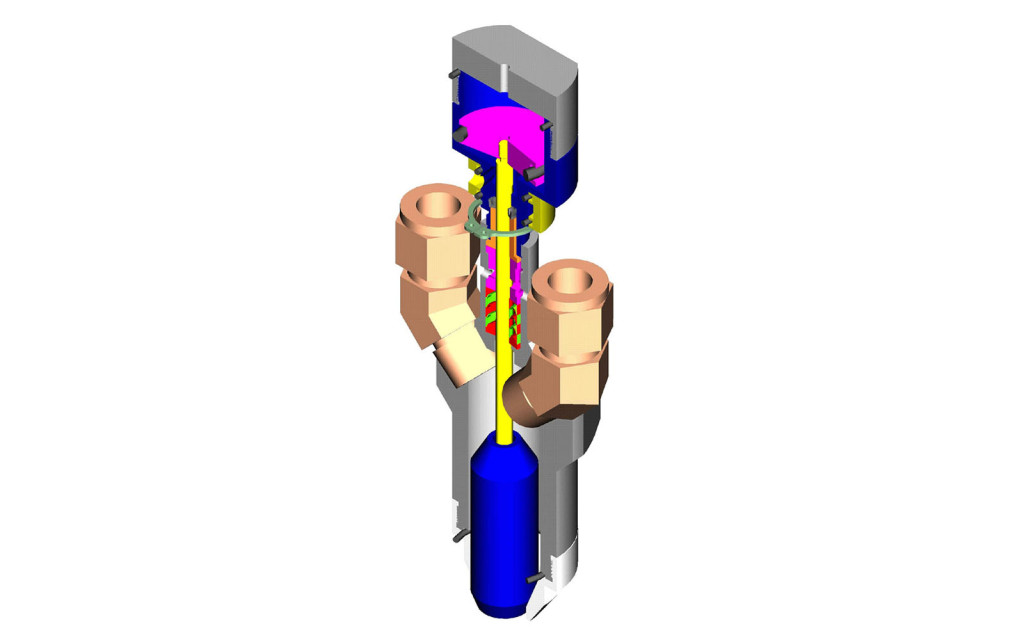
LCN Series Dispensing Nozzle
LCN Series Dispensing Nozzle
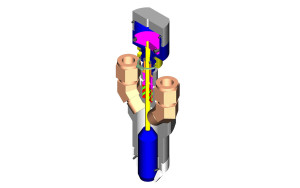 Terco Announces LCN Series Filling Nozzle Development
Terco Announces LCN Series Filling Nozzle Development
Terco Inc., the Bloomingdale, IL (USA) manufacturer of aerosol and liquid filling equipment, announces the development of the Large Capacity Nozzles, otherwise known as the LCN Series. The nozzle series is an addition to the company’s current selection of dispensing nozzles.
The LCN Series was developed to handle products that are either foamy or of higher viscosities than can be easily handled by conventional filling nozzles. The units feature a larger dispensing orifice to increase the ratio of liquid cross section to atmosphere contact area, thus reducing the amount of agitation and air entrapment in the product stream. The nozzle is mounted to an articulated mounting that allows for adjustment to facilitate sidewall filling.
These improvements allow for faster filling times to increase line production speeds. Initial field production tests on aerosol glass cleaner products showed over a 40% reduction in the time required to liquid fill the product as compared with traditional filling nozzles.
In addition to being offered as upgrade options on all of the company’s standard products, the nozzles are designed for retrofitting to machines already in field service. This includes the advantage of being able to be fitted onto other manufacturers filling equipment.
According to the company “… the LCN Series nozzles represents our commitment to use the experience we have gained over the past 35 years to further improve the production output of the modern filling operation. Given the present economy and the increasing need for production line efficiencies, the nozzles offer a viable low cost solution to increasing the capacity of any filling operation.”
The LCN Series nozzles are constructed from either 300 Series or 316 Stainless Steel and feature anti-drip design. They also feature Terco’s dynamic seal technology that allows for adjustment of minor seal wear without the need to replace or rebuild the dispensing nozzle.
For further information:
Terco, Inc.
459 Camden Drive
Bloomingdale, IL 60108
USA
Phone: [+1] (630) 894 8828
Fax: [+1] (630) 894 8846
URL: www.terco.com
Contact: Bernie Brokke sales@terco.com
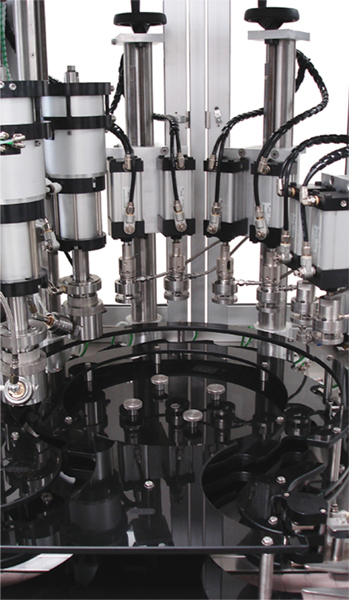
Bag-On-Valve Filling System
Bag-On-Valve Filling System
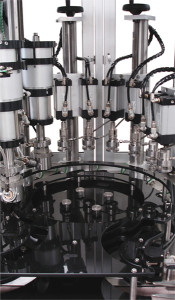 The BOV Rotary Indexing system is designed for use in the production of personal care products in bag-on-valve type containers. The system features the following production quality stations:
The BOV Rotary Indexing system is designed for use in the production of personal care products in bag-on-valve type containers. The system features the following production quality stations:
- Automated bag-valve insertion;
- Automated bag-valve placement verification;
- L.P.A.V. filling system to perform crimping and pre-charging of propellant on a single station. The unit is configured to handle liquefied and compressed gas propellants on the same station;
- HPTV High Pressure Product Fillers with sanitary construction;
- Automated Valve Stem Cleaner system to remove residual product after filling;
- And, online pressure testing for internal pressure verification.
According to the company, “… we have seen a number of applications in the past few years that involve the development of a barrier aerosol product. This product form is becoming increasingly popular by both producers and marketers who need specialized product delivery formats to both enhance their market positions and meet technical product specifications.”
In addition to the above filling system, the company will be displaying a range of aerosol filling stations used on various production systems. This hands-on display will allow exhibition visitors to view different production methods for their individual production needs. All of the stations displayed can be mounted to a range of standardized machine bases for varying line speed formats.
For 40 years the company has been manufacturing aerosol filling systems, and has been heavily involved in barrier and compartmental aerosol filling systems for over 25 years. In addition to their equipment for the filling of traditional aerosols, they offer filling systems for every type of barrier aerosol product in the industry today.
As a full line supplier of aerosol and filling equipment, Terco offers a complete range of ancillary equipment including: can feeding, conveyors, water bath test tanks, container accumulators, tip placers, overcap placers, pressure testers, propellant handling systems, safe filling rooms, and puck handling equipment.
Terco, Inc., located in Bloomingdale, IL USA, offers a worldwide technical sales and support network that includes global stocking of spare parts. With customers in over 45 countries the company has a reputation for offering dependable and flexible filling solutions.
See also:
What is Bag-On-Valve (BOV) Aerosol Filling?
Why use BOV Bag-On-Value Aerosol Filling?
Terco, Inc.
459 Camden Drive
Bloomingdale, IL 60108
USA
Phone: [+1] (630) 894-8828
Fax: [+1] (630) 894-8846
Contact: Bernie Brokke sales@terco.com
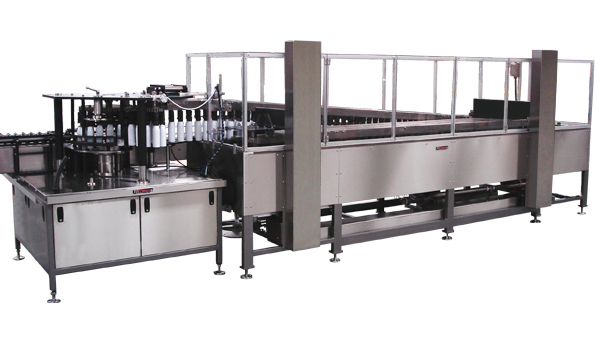
Gripper Water Bath
TERCO GRIPPER WATERBATH
The Gripper Waterbath has been designed for use with aerosol containers of various materials. The gripper style clips allow for the testing of tinplate, aluminum, plastic and glass containers.
The stainless steel carriage chain is configured with internal grippers as a standard. External grippers are available at no additional charge, but must be specified at time of order placement.
The system features a continuous motion rotary base for the loading and unloading of containers. The base is constructed from epoxy coated, structural steel and clad in polished stainless steel. The base is outfitted with an automatic chain tensionor for the carriage chain to ensure smooth and consistent container handling.
The tank section is constructed from polished stainless steel and supported by an epoxy coated, structural steel frame. The outer portions of the tank can be insulated with foam and clad in polished stainless steel.
Both the rotary base and the tank are secured with a safety enclosure that is interlocked into the machines drive logic. The doors of the enclosure are mechanically secured during normal operation and can only be accessed when the machine is not in ‘run’ operation. The enclosure is constructed with a clear anodized, aluminum frame and glass door panels. An exhaust vent port is configured over the tank section.
The carriage system that transports the cans through the tank is outfitted with an automated lifting system. In the event that a line stoppage occurs, the containers will automatically be lifted from the water. When returned to the water, the cans are held in a pre-set dwell time before continuing to transport through the machine.
Over the discharge transfer conveyor is a side blow-off assembly to remove residual water from the sides and top of the can and the cup section of the aerosol valve. It comes complete with a turbine blower rated for a hazardous location
Terco, Inc.
459 Camden Drive
Bloomingdale, IL 60108
United States
Phone: [+1] 630-894-8828
Fax: [+1] 630-894-8846
Contact: Bernie Brokke sales@terco.com

